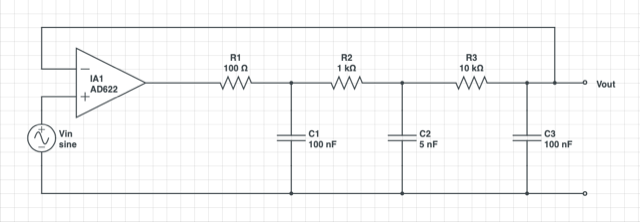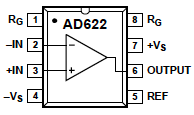Difference between revisions of "Electronics bootcamp II: feedback systems"
From Course Wiki
MAXINE JONAS (Talk | contribs) (→Time and frequency response of a feedback system) |
MAXINE JONAS (Talk | contribs) (→Time and frequency response of a feedback system) |
||
| (2 intermediate revisions by one user not shown) | |||
| Line 21: | Line 21: | ||
|} | |} | ||
</center> | </center> | ||
| + | [[Image:AD622Pinout.png|350px|center]] | ||
# Find the transfer function of the RC network inside the feedback loop (not including the amplifier). '''Use an appropriate approximation to dramatically simplify the algebra'''. | # Find the transfer function of the RC network inside the feedback loop (not including the amplifier). '''Use an appropriate approximation to dramatically simplify the algebra'''. | ||
| Line 28: | Line 29: | ||
# Connect the output of your circuit to channel 2 of the oscilloscope. | # Connect the output of your circuit to channel 2 of the oscilloscope. | ||
# Set the function generator to produce a 100 Hz, square wave output with an amplitude of 100 mV. | # Set the function generator to produce a 100 Hz, square wave output with an amplitude of 100 mV. | ||
| − | # Adjust R<sub>gain</sub> (between pins 1 and 8 of the AD622 instrumentation amplifier) so that the system response is slightly overdamped | + | # Adjust R<sub>gain</sub> (between pins 1 and 8 of the AD622 instrumentation amplifier) so that the system response is slightly overdamped and record the response. |
| − | + | # Adjust R<sub>gain</sub> so that the circuit is critically damped and record the response. | |
| − | + | ||
| − | + | ||
| − | # Adjust R<sub>gain</sub> so that the circuit is critically damped and | + | |
#* To achieve critical damping, start with an over damped response and vary R<sub>gain</sub> by turning the potentiometer until there is a slight overshoot in the response. Then turn the potentiometer back until the overshoot just disappears. | #* To achieve critical damping, start with an over damped response and vary R<sub>gain</sub> by turning the potentiometer until there is a slight overshoot in the response. Then turn the potentiometer back until the overshoot just disappears. | ||
| − | # Adjust R<sub>gain</sub> so that the circuit is slightly underdamped (two or three overshoots) and | + | # Adjust R<sub>gain</sub> so that the circuit is slightly underdamped (two or three overshoots) and record the response. |
| − | # Adjust R<sub>gain</sub> so that the circuit is underdamped with at least a dozen or so overshoots and | + | # Adjust R<sub>gain</sub> so that the circuit is underdamped with at least a dozen or so overshoots and record the response. |
| + | {{Template:Assignment Turn In|message = | ||
| + | * Find the transfer function of the low-pass circuit in the diagram | ||
| + | * Build the amplifier/low-pass circuit in the diagram | ||
| + | * For your lab report: include a picture of the circuit you and four photos of the oscilloscope showing the step response for overdamped, critically damped, slightly underdamped, and underdamped step responses (similar to the ones in the lab manual). | ||
| + | }} | ||
{{Template:20.309 bottom}} | {{Template:20.309 bottom}} | ||
Latest revision as of 19:08, 1 November 2019
--Steven Wasserman (talk) 21:14, 27 October 2018 (CDT)
Time and frequency response of a feedback system
In the second part of the boot camp, you will build the circuit below and characterize its time and frequency response.
| Overdamped | Critically damped |
|---|---|
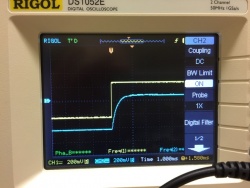
|
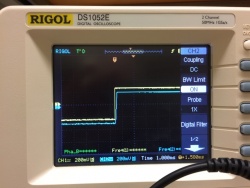
|
| Slightly underdamped | Underdamped |

|
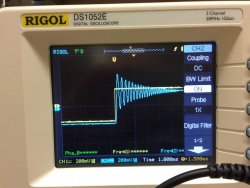
|
- Find the transfer function of the RC network inside the feedback loop (not including the amplifier). Use an appropriate approximation to dramatically simplify the algebra.
- Find the transfer function of the entire system, including the amplifier, as a function of the amplifier's open-loop gain, A.
- Build and test the circuit in the diagram.
- Connect the output of a signal generator to channel 1 of an oscilloscope and also to the input of your circuit.
- Connect the output of your circuit to channel 2 of the oscilloscope.
- Set the function generator to produce a 100 Hz, square wave output with an amplitude of 100 mV.
- Adjust Rgain (between pins 1 and 8 of the AD622 instrumentation amplifier) so that the system response is slightly overdamped and record the response.
- Adjust Rgain so that the circuit is critically damped and record the response.
- To achieve critical damping, start with an over damped response and vary Rgain by turning the potentiometer until there is a slight overshoot in the response. Then turn the potentiometer back until the overshoot just disappears.
- Adjust Rgain so that the circuit is slightly underdamped (two or three overshoots) and record the response.
- Adjust Rgain so that the circuit is underdamped with at least a dozen or so overshoots and record the response.

